Reality capture, or more broadly the idea of using laser scanners and/or photography to create accurate 3D models of real-life assets, is a fascinating space because of both how new it is and the wide array of applications. We are constantly seeing new innovations in the space, such as recent advancements in NeRFs and Gaussian Splats which make creating these models much less labor intensive, and also new industries taking advantage of this. We see the technology applied constantly in areas we’d expect, like on construction sites and around facilities and utilities for inspections, as well as some places that wouldn’t immediately come to mind. Sprinkled into those realizations, we also see new ways of collecting the data necessary to create models.
Today as we look around stories related to 3D technology from friends around the industry, we see both ends of the spectrum of use cases for reality capture. In our first story, we look at a more typical (for lack of a better word) use case for laser scanning: Scan-to-BIM, but still looking at how modern innovations can apply to the space. Next, we go to a less conventional use case, with laser scanners being used in the art world. Finally, we look at a new location for a show that focuses on commercial applications for drones, which of course includes reality capture. Find the full stories below.

Automating Scan to BIM Workflows for Faster and Accurate Model Creation
Lidar News
We start out with a look at how advancements in artificial intelligence and machine learning (AI/ML) can benefit Scan-to-BIM workflows. Implementing these kinds of workflows into BIM projects has been a major boon for those who have taken the plunge, but it’s also a time-consuming and sometimes tedious process that requires parsing through massive amounts of data. In other words, it’s exactly the type of workflow that would benefit from AI and ML. This article highlights how this application can help professionals in the industry, and links to a longer report for more on the subject.

‘Almost a clone’: How 3D-printing can reproduce multi-million-dollar masterpieces, stroke by stroke
Oscar Holland, CNN
Now, we go from the “conventional” use case in AEC workflows to a less conventional application of laser scanning in the art world. This is a bit of an older feature from CNN, dating back to late last year, but Holland details how the art community is using laser scanning and 3D printing make access to high-quality artwork more accessible. Nothing is like owning an original piece, of course, but this article outlines how laser scanners have been used to collect, in great detail, every aspect of a painting down to individual brush strokes to then recreate paintings using 3D printing.

Amsterdam Drone Week Announces Strategic Partnership with Commercial UAV Expo
Commercial UAV News
There are many different ways professionals are capturing 3D data, whether it be with terrestrial laser scanners, mobile mapping systems that are held, or on backpacks, or on ground robots, or on vehicles, etc. One of the most popular ways has long been attaching sensors to drones, allowing data to be collected more quickly and/or more safely, and from above. Commercial UAV Expo, a sister show of Geo Week, covers commercial applications of UAVs, including this kind of data collection. Last week, it was announced that they’d be expanding their show to Europe alongside Amsterdam Drone Week, starting in 2025.






